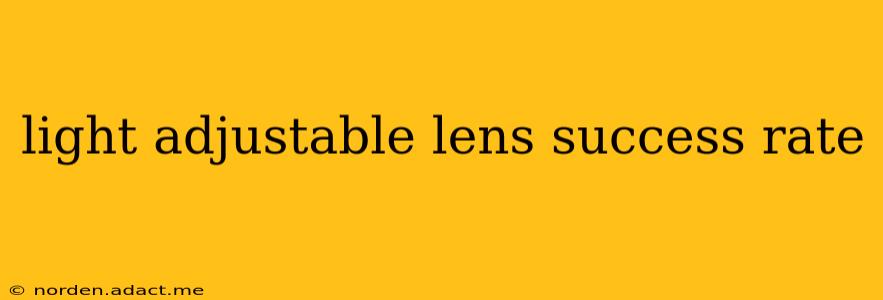Light Adjustable Lenses (LALs) represent a significant advancement in refractive surgery, offering a level of precision and adjustability previously unimaginable. But what's the actual success rate, and what should you expect from this innovative procedure? This article dives deep into the world of LALs, addressing common questions and concerns surrounding their effectiveness.
What is the Success Rate of Light Adjustable Lenses?
The success rate of Light Adjustable Lenses varies depending on several factors, including the individual patient's unique eye characteristics, the surgeon's experience, and the specific goals of the procedure. While precise numbers are difficult to pinpoint due to the relatively new nature of the technology and ongoing research, studies suggest high satisfaction rates among patients who undergo LAL implantation. Many ophthalmologists report success rates exceeding 90% in achieving patients' desired visual acuity, meaning they reach their target refractive correction. It's crucial to understand that "success" is defined not just by achieving 20/20 vision, but by reaching the patient's individual visual goals, which might be 20/25, 20/40, or even improving their vision enough to reduce their reliance on glasses or contacts.
What are the Potential Complications of Light Adjustable Lenses?
While generally considered safe, LALs, like any surgical procedure, carry potential risks and complications. These can include, but are not limited to:
- Undercorrection or Overcorrection: Even with the adjustability of LALs, achieving perfect vision isn't guaranteed. Minor adjustments might be needed, or in rare cases, further corrective procedures might be necessary.
- Dry Eyes: Dry eye syndrome is a common side effect of many refractive surgeries, and LAL implantation is no exception.
- Halos or Glare: Some patients report experiencing halos or glare, especially at night, after the procedure. The severity of this varies greatly among individuals.
- Infection: As with any surgery, there's a risk of infection. However, this is a rare occurrence with proper post-operative care.
- Lens Opacity: In rare cases, the lens might become cloudy or opaque, requiring further intervention.
It’s vital to discuss these potential complications thoroughly with your ophthalmologist before deciding to proceed with the procedure.
How Long Does the Light Adjustable Lens Treatment Last?
The longevity of the Light Adjustable Lens correction is a frequently asked question. Current data suggests that the effects of the procedure are long-lasting, with many patients maintaining their improved vision for several years. However, it's important to note that like natural vision, there can be some age-related changes that could gradually affect the refractive state of your eyes over time. Regular eye exams are still crucial to monitor the long-term effects and address any potential changes.
Are Light Adjustable Lenses Right for Everyone?
LALs aren't suitable for every individual. Several factors influence candidacy, including:
- Age: LALs are typically suitable for adults whose eyes have stopped growing.
- Eye Health: Existing eye conditions, like cataracts, corneal diseases, or certain types of glaucoma, may disqualify someone from undergoing the procedure.
- Corneal Thickness: Sufficient corneal thickness is essential to ensure proper lens implantation.
A comprehensive eye exam by a qualified ophthalmologist is vital to determine suitability. They'll assess your eye health, refractive error, and other relevant factors to ascertain if LALs are the right option for you.
How Much Does Light Adjustable Lens Surgery Cost?
The cost of Light Adjustable Lens surgery can vary depending on your location, the ophthalmologist's fees, and any additional associated charges. It’s typically more expensive than traditional LASIK or other refractive surgeries, but this added cost is often justified by the potential for greater precision and the possibility of adjustments after the initial procedure. It's advisable to contact several ophthalmologists in your area to get a better understanding of the pricing structure and associated fees.
What is the Recovery Time After Light Adjustable Lens Implantation?
The recovery period after LAL implantation is generally shorter than that of some other refractive surgeries. Most patients experience minimal discomfort and can resume many normal activities within a day or two. However, it's crucial to follow your ophthalmologist's instructions diligently regarding post-operative care, including using prescribed eye drops and avoiding strenuous activities. Complete visual recovery might take several weeks, as the lenses gradually settle and the adjustments are finalized.
This information is intended for educational purposes only and should not be considered medical advice. Always consult with a qualified ophthalmologist to discuss your individual needs and the suitability of Light Adjustable Lenses. They can provide a personalized assessment and help you make informed decisions about your vision correction options.
